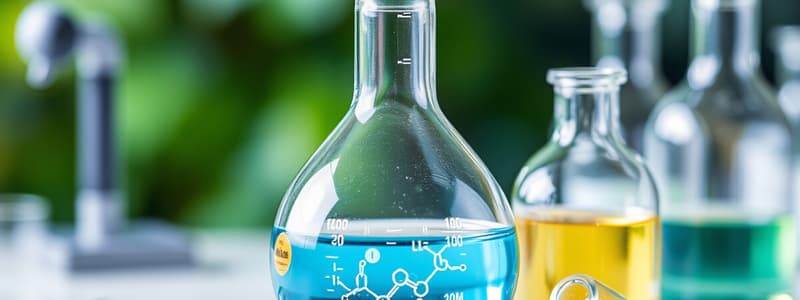Podcast
Questions and Answers
What is chemistry?
What is chemistry?
- The scientific study of matter and its changes. (correct)
- The examination of rocks and minerals.
- The study of living organisms.
- The exploration of physical spaces.
What is matter?
What is matter?
Anything that occupies space and has weight.
What does organic chemistry deal with?
What does organic chemistry deal with?
Matter that is now living or was alive, with carbon present.
What is the focus of inorganic chemistry?
What is the focus of inorganic chemistry?
What defines a solid?
What defines a solid?
What is a liquid?
What is a liquid?
How is a gas defined?
How is a gas defined?
What is a physical change?
What is a physical change?
Define a chemical change.
Define a chemical change.
What are elements?
What are elements?
What is an atom?
What is an atom?
What are protons?
What are protons?
What role do neutrons play in an atom?
What role do neutrons play in an atom?
What are electrons?
What are electrons?
Define a molecule.
Define a molecule.
What are amino acids?
What are amino acids?
What is a peptide bond?
What is a peptide bond?
Match the following bonds with their characteristics:
Match the following bonds with their characteristics:
Study Notes
Chemistry Overview
- Chemistry is the scientific study of matter, including its physical and chemical changes.
- Matter is defined as anything that occupies space and has weight, including solids, liquids, and gases.
Types of Chemistry
- Organic Chemistry focuses on matter that is or was alive, characterized by the presence of carbon, such as plants and animals.
- Inorganic Chemistry studies matter that is not and never has been alive, excluding carbon-based materials like rocks and minerals.
States of Matter
- Solids have a definite weight, volume, and shape.
- Liquids possess a definite weight and volume but do not have a definite shape.
- Gases have a definite weight but exhibit indefinite volume and shape.
Changes in Matter
- Physical Change involves altering physical characteristics without forming a new substance, e.g., melting ice or crushing a can.
- Chemical Change results in new substances with different chemical characteristics, e.g., rust formation or baking a cake.
Elements and Atoms
- All matter consists of atoms that form elements; these elements are basic substances that cannot be broken down further.
- An atom is the smallest complete unit of an element, consisting of protons, neutrons, and electrons.
Subatomic Particles
- Protons carry a positive charge and identify the type of atom (e.g., hydrogen or oxygen).
- Neutrons have no charge and contribute to the atomic weight.
- Electrons possess a negative charge and facilitate chemical bonding between atoms.
Molecules and Proteins
- Molecules are formed when two or more atoms bond together chemically, often by sharing electrons.
- Amino Acids are compounds that comprise carbon, oxygen, hydrogen, and nitrogen, forming the building blocks of proteins necessary for body growth and tissue repair.
- Peptide Bonds link amino acids end-to-end to create protein structures.
Side Bonds in Hair
- Side bonds in keratin proteins include hydrogen bonds, salt bonds, disulfide bonds, and van der Waals forces, each serving distinct functions.
- Hydrogen Bonds are individually weak but collectively contribute about 35% of hair's strength and can be broken by heat or water.
- Salt Bonds also contribute 35% to hair's resistance to change and help organize protein chains.
- Disulfide Bonds are crucial for chemical services in hair, such as perming and relaxing, affecting shape and structural integrity.
- Van der Waals Forces, while less significant in salon work, play a role in bonding chains within multimolecular structures.
Studying That Suits You
Use AI to generate personalized quizzes and flashcards to suit your learning preferences.
Description
Test your knowledge with this set of flashcards covering key concepts in chemistry. Each card features essential terms and definitions, including matter and organic chemistry. Perfect for students looking to reinforce their understanding of chemical principles.




